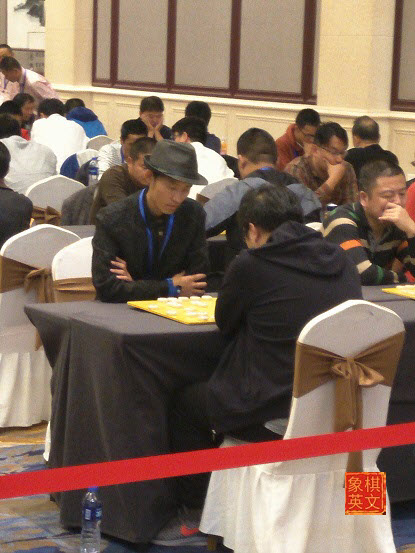Introduction to the ECCO Classification
 ECCO is the acronym for Encyclopedia of Chinese Chess Opening and is a reflection of contemporary Xiangqi openings. It is the first and only (thus far) system for Xiangqi openings that I have found. It was found at the link below.
ECCO is the acronym for Encyclopedia of Chinese Chess Opening and is a reflection of contemporary Xiangqi openings. It is the first and only (thus far) system for Xiangqi openings that I have found. It was found at the link below.
http://www.xqbase.com/ecco/ecco_intro.htm
ECCO first appeared in 2004. It was created by Huang Chen and his team for their own Xiangqi viewer called Xq Wizard. Their website was www.xqbase.com .
Some of its merits include the ability to categorize the less seen openings like P1+1 or A4+5 while at the same time being able to list the commonly used openings like the central cannon vs screen horse defense with edge cannon for chariot exchange variation.
According to information given on the site, it was initially called ECCO 2004 as there were 8197 games collected and categorized by the authors up till 2004.
To begin with, there are four main orthodox openings for Red:
- a) Cannon openings (Central Cannon, Palcorner Cannon, Cross Palace Cannon),
- b) Elephant openings,
- c) Horse openings,
- d) Pawn openings.
“Unorthodox” openings like the single horned monster 独角兽, the nine-tailed tortoise 九尾龟 , tandem cannons counter 迭炮 , golden hooked cannons 金钩炮, phoenix cannons counter凤凰炮 also known as the turtle back cannon 龟背炮 etc… were unclassifiable in the past. ECCO has been able to overcome this situation.
Orthodox Black counters include:
- Same Direction Cannons (against Central Cannon)
- Opposite Direction Cannons (against Central Cannon)
- Screen Horse Defense (against Central Cannon)
- Single Horse Defense (against Central Cannon)
- Sandwiched Horse Defense (against Central Cannon)
- Thundering Defense (against Pawn Opening)
- Cross-Palace Counter, Palcorner Cannon Counter (against the Elephant opening)
Unorthodox counters include the Turtle Back Cannons, Tandem Cannon Defense, Phoenix Cannons, Riverbank Fortress Cannon (探头炮) et cetera. A counter can sometimes transposition into another formation or counter making the nomenclature very difficult.
Basic ECCO classification :
 There are basically 5 broad categories to ECCO:
There are basically 5 broad categories to ECCO:
- A) Non-central cannon openings (not inclusive of the Angle Pawn) : includes the Cross Palace Cannon Opening, the Palcorner Cannon Opening, the Elephant opening, the Horse Opening. The above mentioned openings are considered orthodox. Unorthodox/irregular openings like the Advisor Opening, Chariot Opening, One Horned Monster/Nine-tailed tortoise openings are also included in this section.
- B) Central Cannon vs Sandwiched Horse Defense
- C) Central Cannon vs Screen Horse Defense
- D) Same Direction Cannons and Opposite Direction Cannons (inclusive of the Deferred Opposite Direction Cannons)
- E) Pawn Openings
Each opening and counter is basically represented by a capital letter (A-E) followed by a two digit number. For example, D28 would refer to Same Direction Cannons: filed chariot with double headed snake pawn formation vs ranked chariot.
The authors emphasize a merit over ECO (Encyclopedia of Chess Openings) for international chess in that there have been allotted extra digits to make way for possible future “orthodox” variations.
How the ECCO label is formed:
The ECCO label is arrived based on the following criteria.
a) The order of the moves.
Based on the “opening tree” (that is, the algorithm you get when you take into consideration ALL the possible opening moves), most NON-Central Cannon openings will arrive at some common formation. This formation would be then given an ECCO label. For example, A40 ( a variation of the horse opening) would refer to the same formation arrived even though the pawn opening may be played first.
b) The process of making the moves.
The order of first few moves that are played before a predetermined formation is arrived may not influence the final formation. This has been a problem for the authors of the classification system but generally, as long as the moves are played in logical order and can arrive at the same formation, it would be given the same label.
For example, in the double headed snake pawn formation, it would not matter much if P3+1 is played before P7+1 or vice versa, and as long as both moves are played, it would arrive at the double headed snake pawn formation.
To further validate this point, D28 is given as the label to represent the following opening, “Same Direction Cannons: Filed chariot with Double headed snake pawn formation vs Ranked Chariot. It would not matter if red played P3+1 or P7+1 as long as both moves are played, it would be the double headed snake pawn formation.
c) Formations occurring with high frequencies:
In openings where it is very commonly played, the classification becomes trickier. Basically, the authors have determined which pre-determined formation is reached first and the moves that follow would be designated as its variation.
The Central Cannon vs Screen Horse Defense is THE most played opening. In such an instance, ECCO would have labeled many different common formations. It takes into consideration that the same formation CAN and WILL be arrived from a different order of moves. For example, in perhaps the most commonly used opening, the Central cannon 7th Pawn Advancement with Pawn Ranked Chariot vs Screen Horse Defense 7th Pawn Advancement is designated as C30-C49. There are 24 possibilities for the order of moves to arrive at this formation. In such an instance, the authors have recognized the major formation and the rest of the moves will be the variation or sub-variations of this opening. Therefore, if black played the Edge Cannon for Chariot Exchange variation, it would be labeled as C49 and is considered to be a variation of the Central Cannon 7th Pawn Advancement with Pawn ranked Chariot vs Screen Horse Defense with 7th Pawn advancement and Edge Cannon for Chariot Exchange variation.
Click here for a full document on ECCO in English by the Webmaster.
Click here for a short summary on ECCO.
